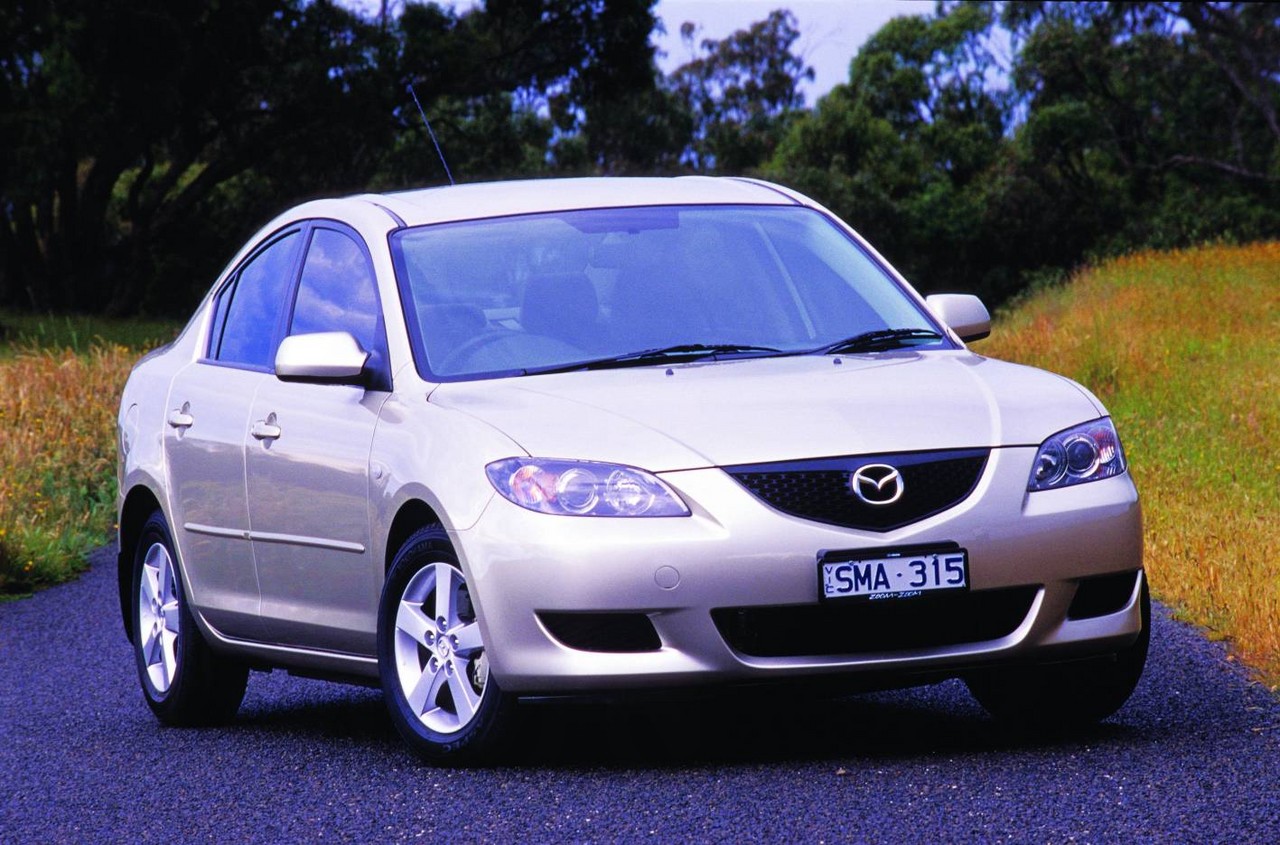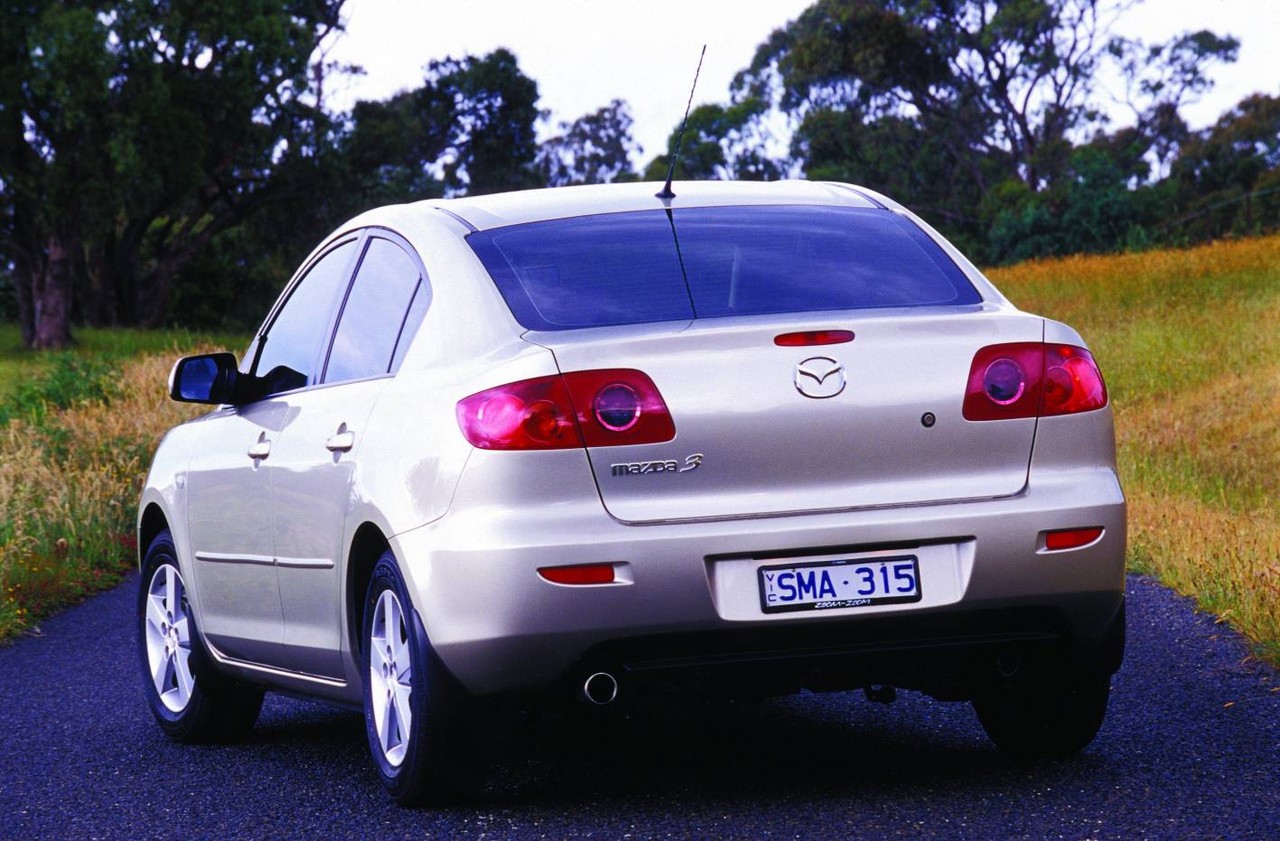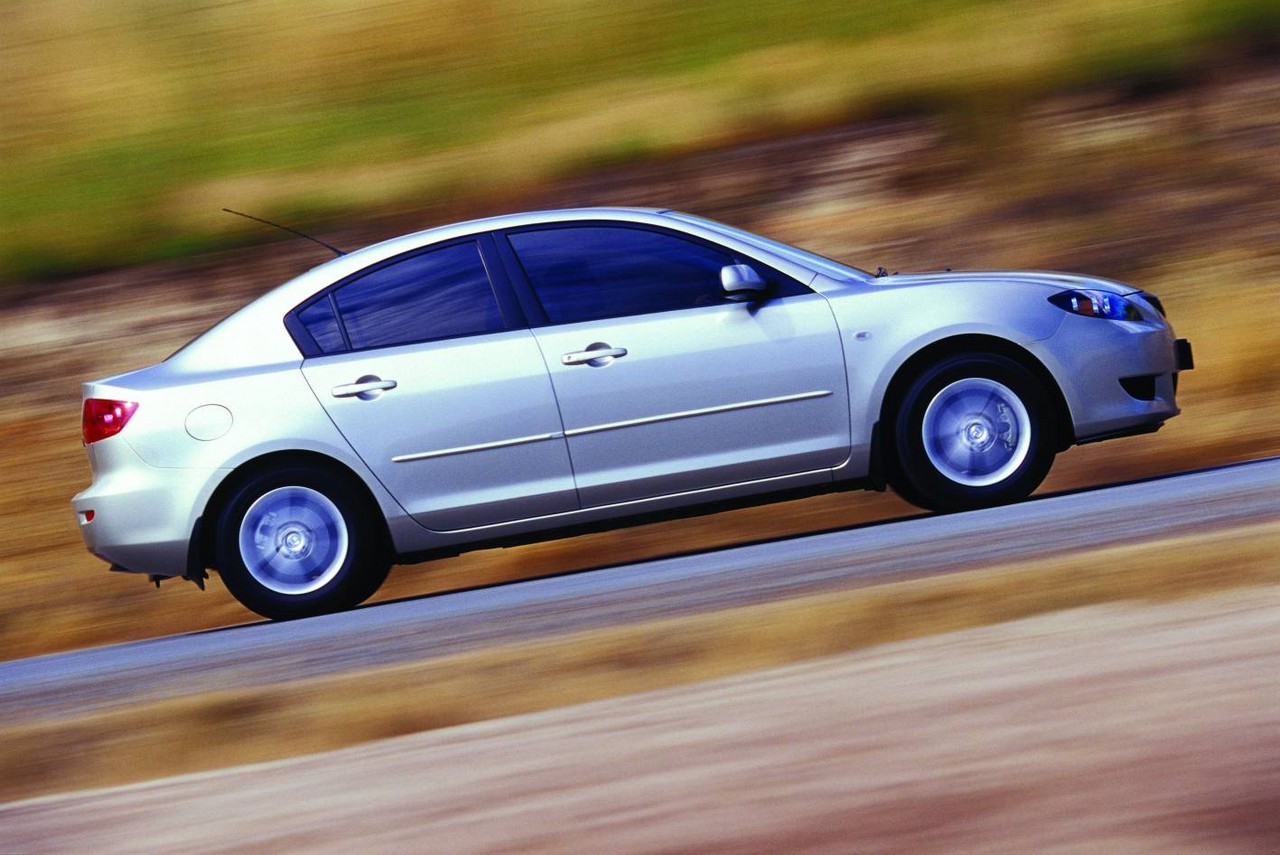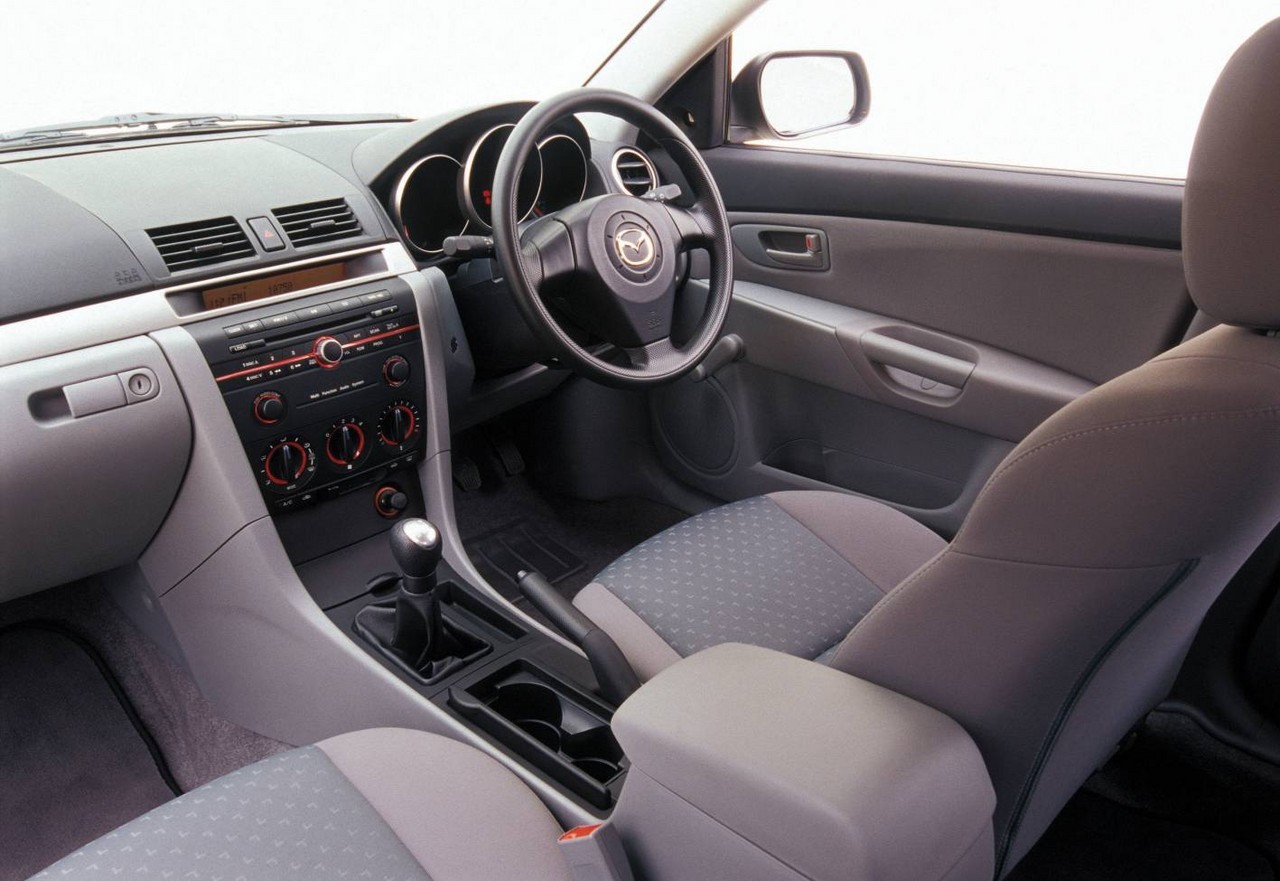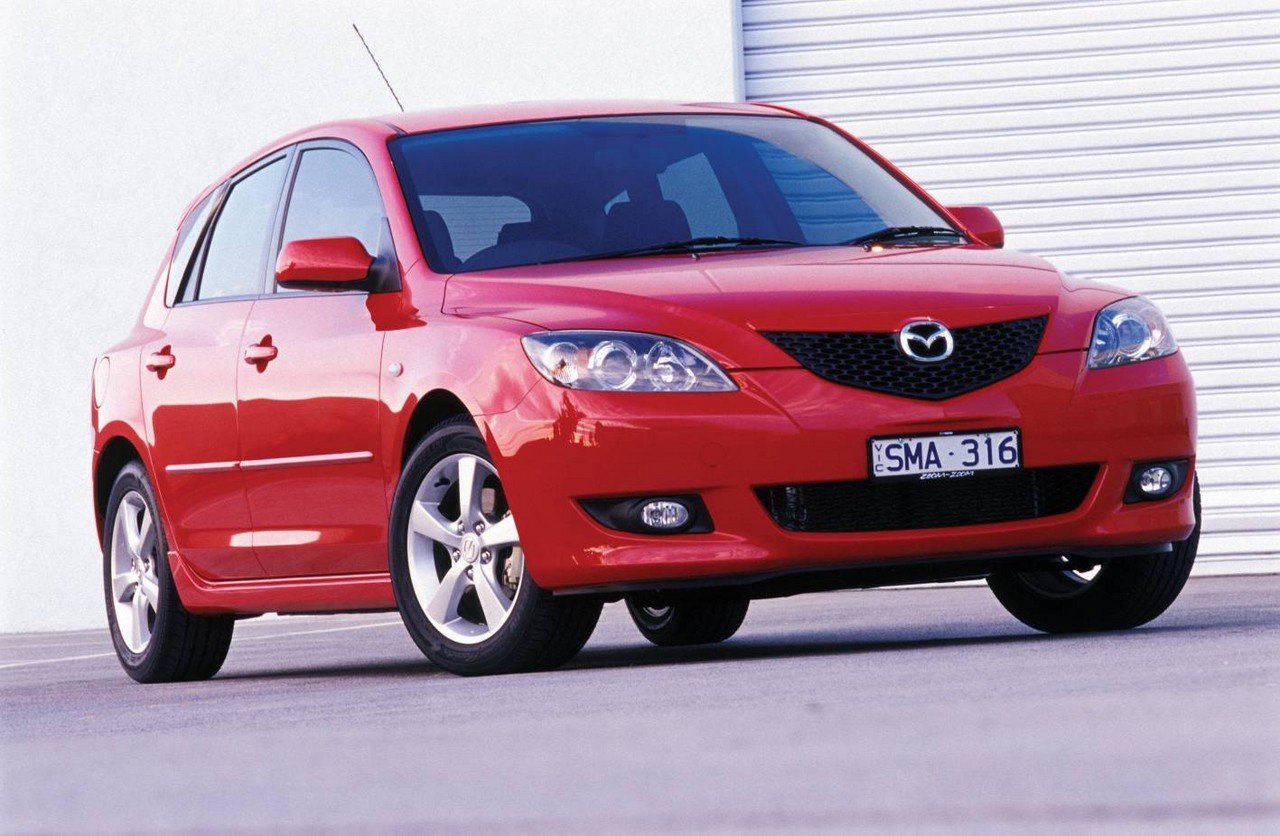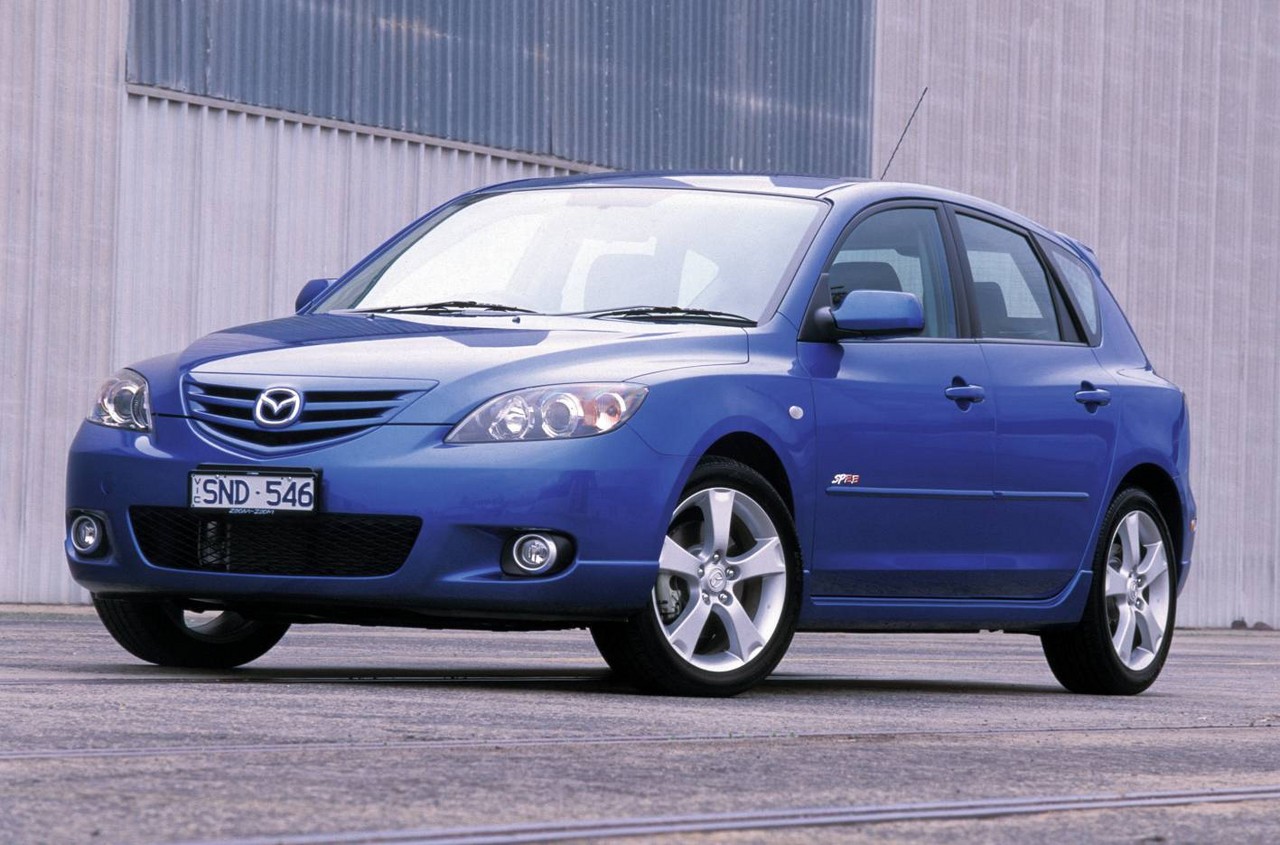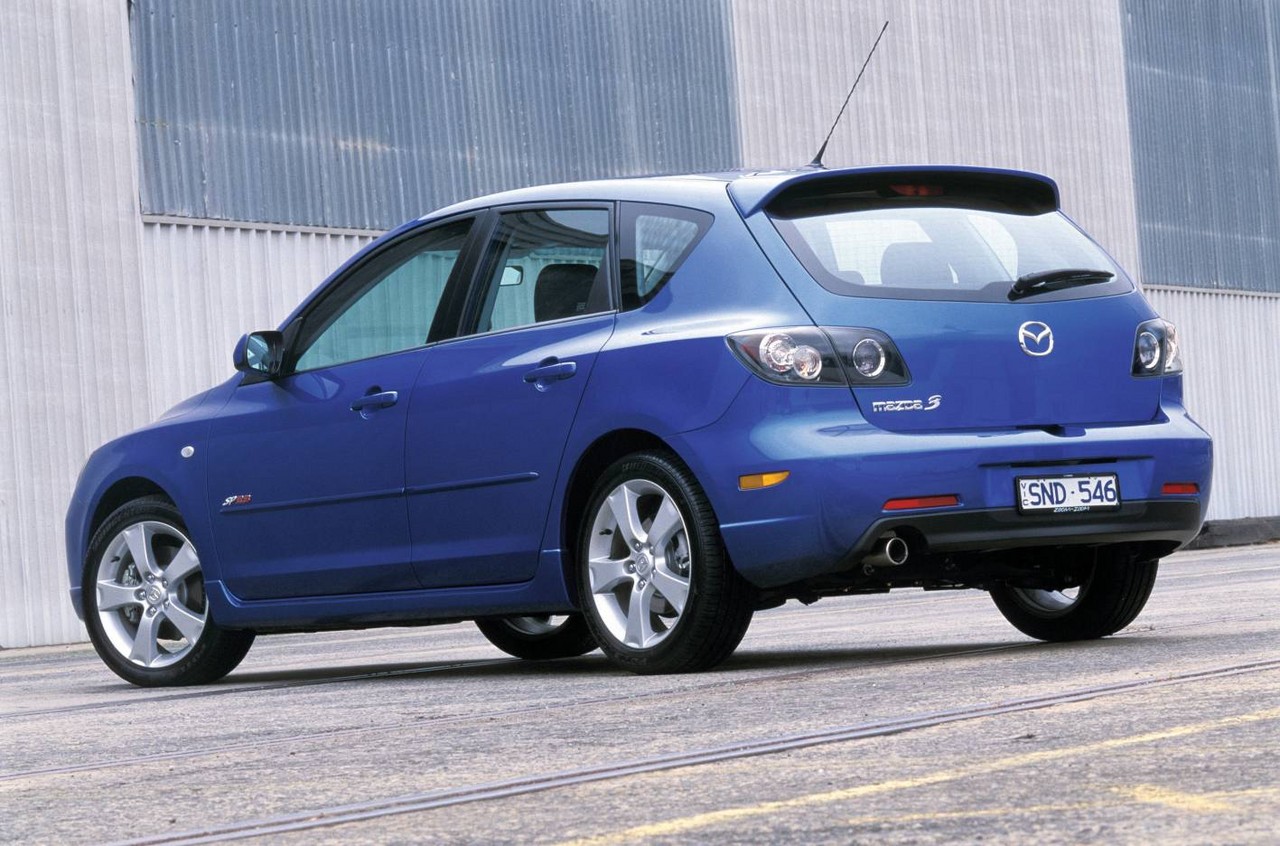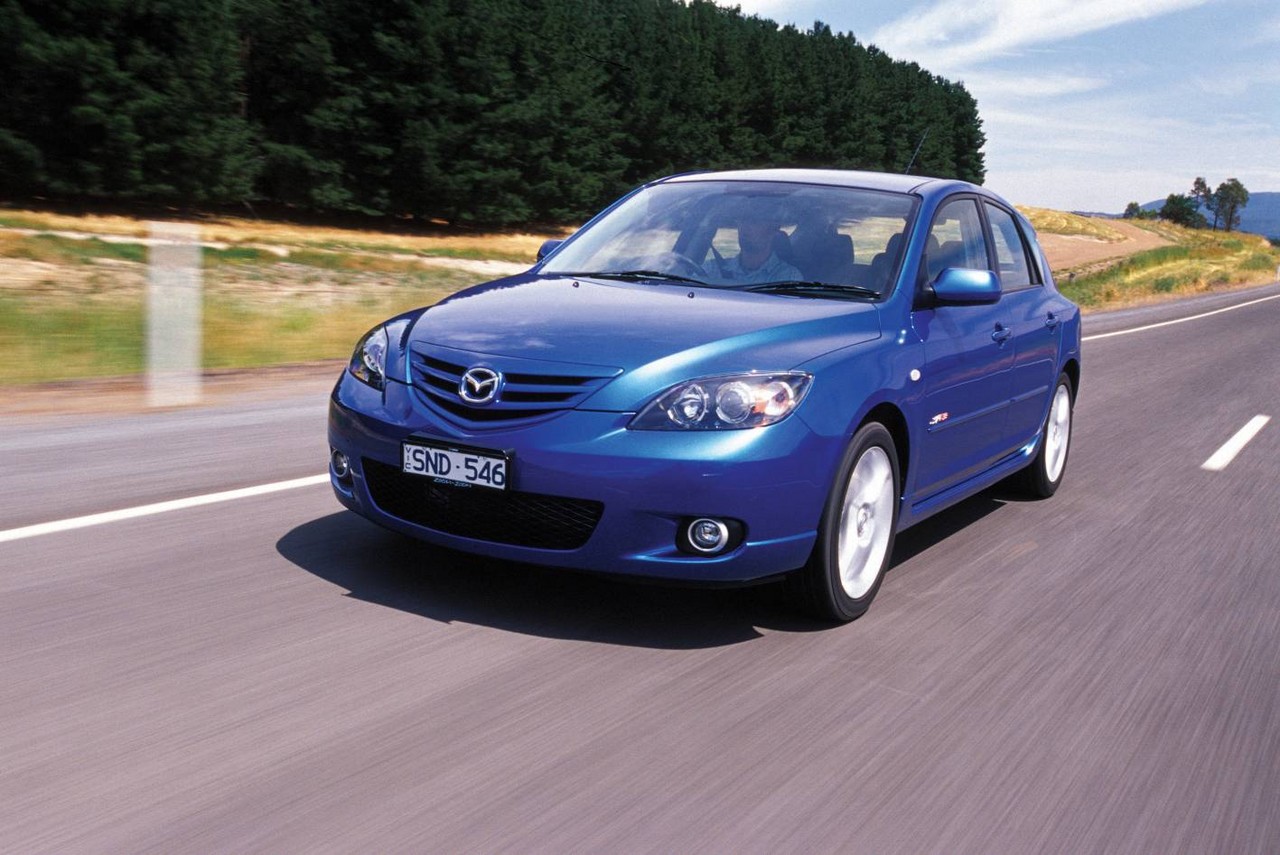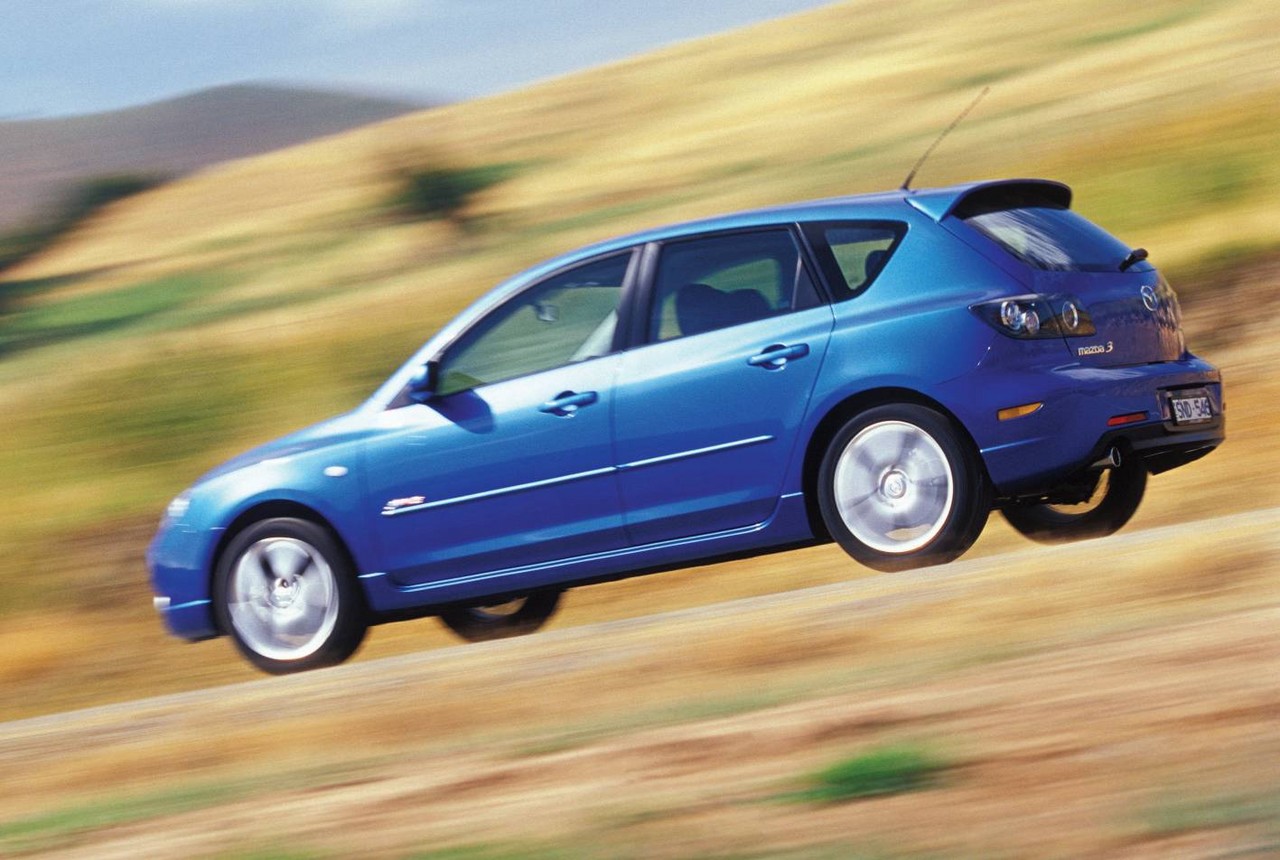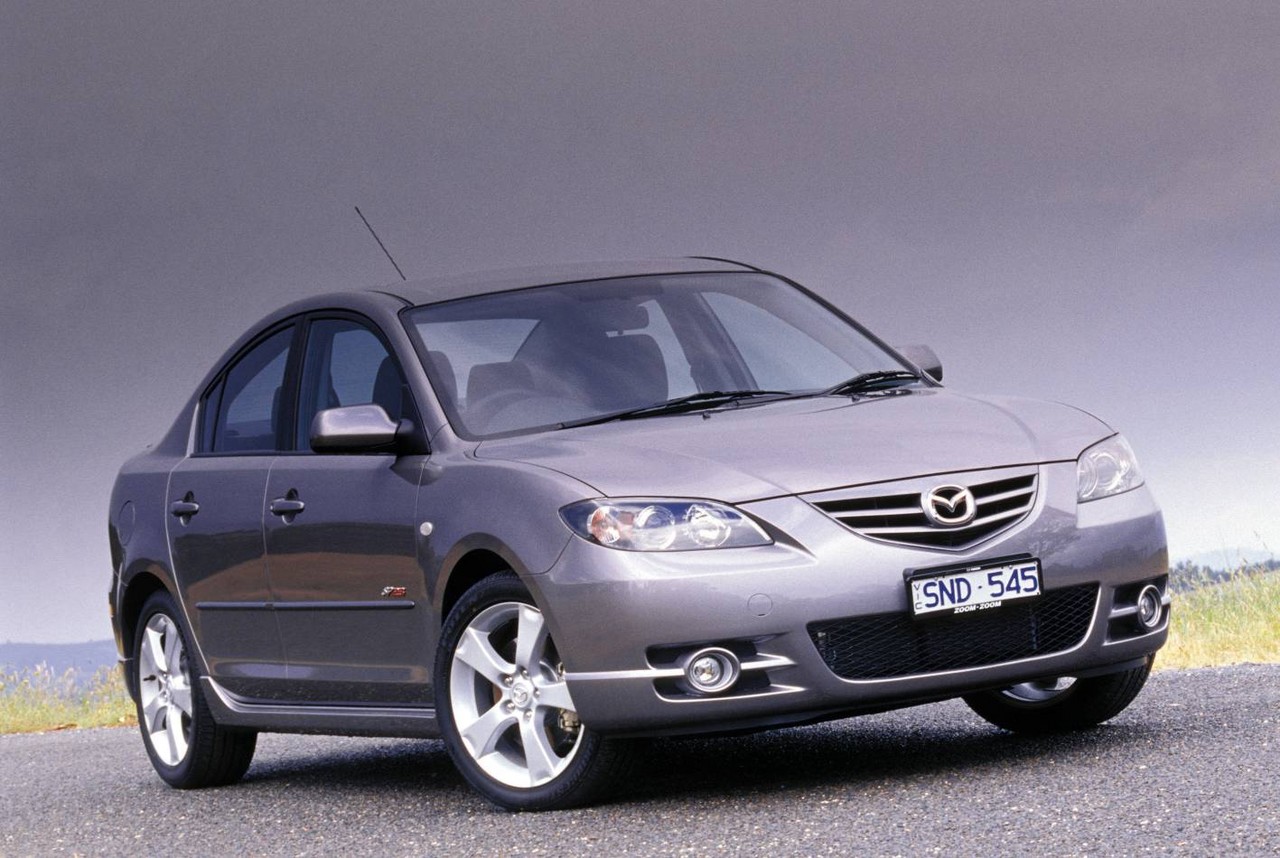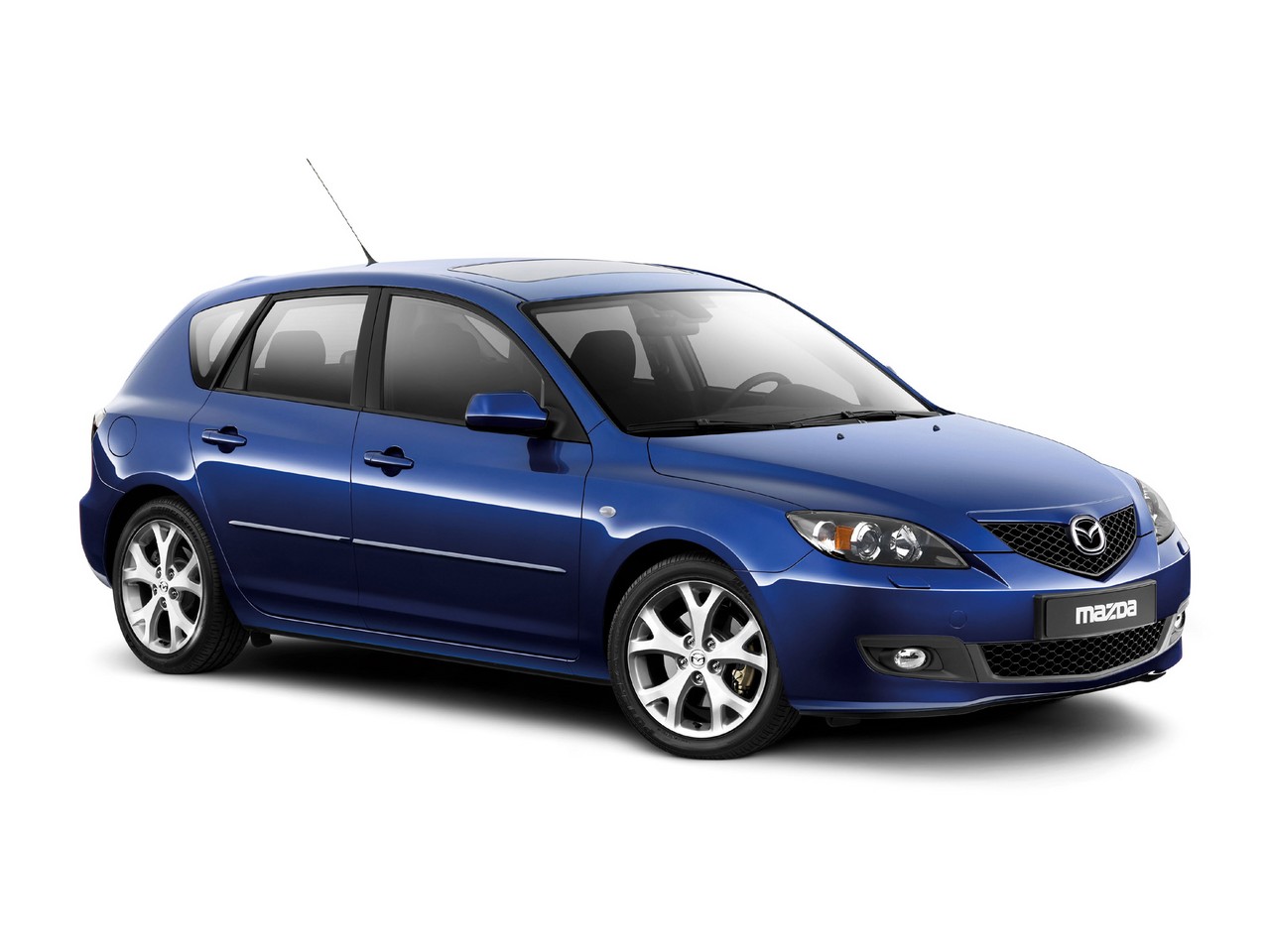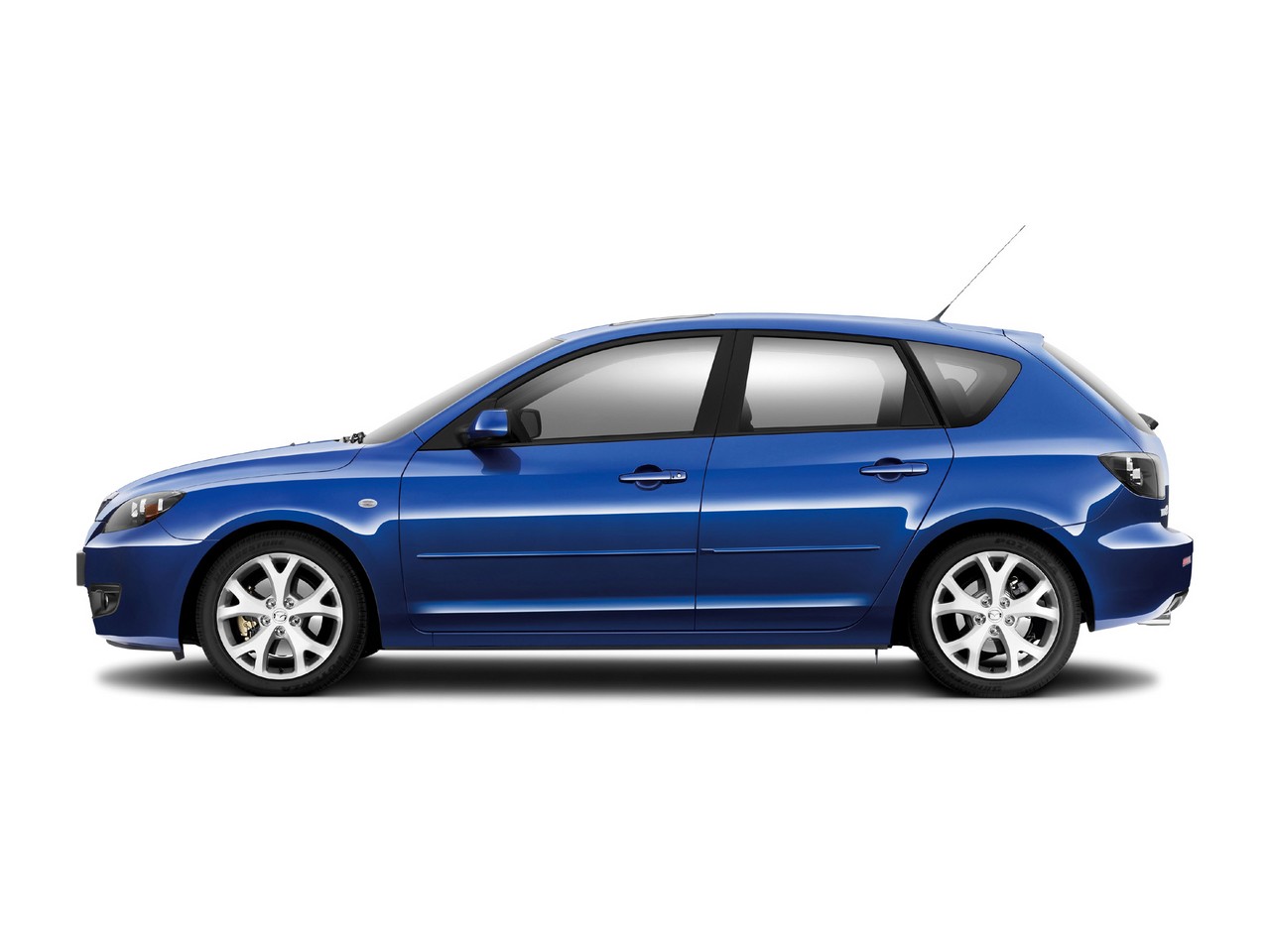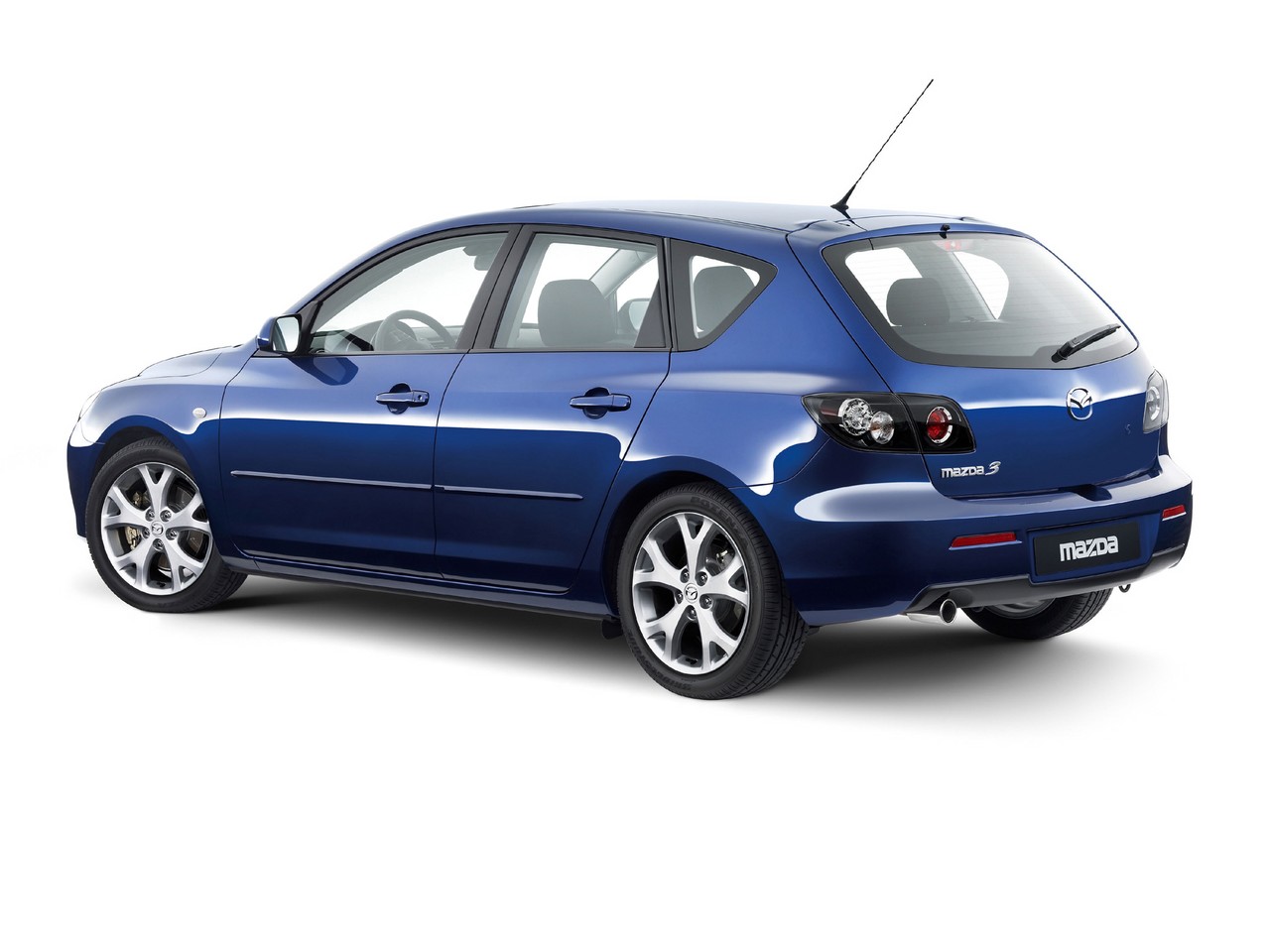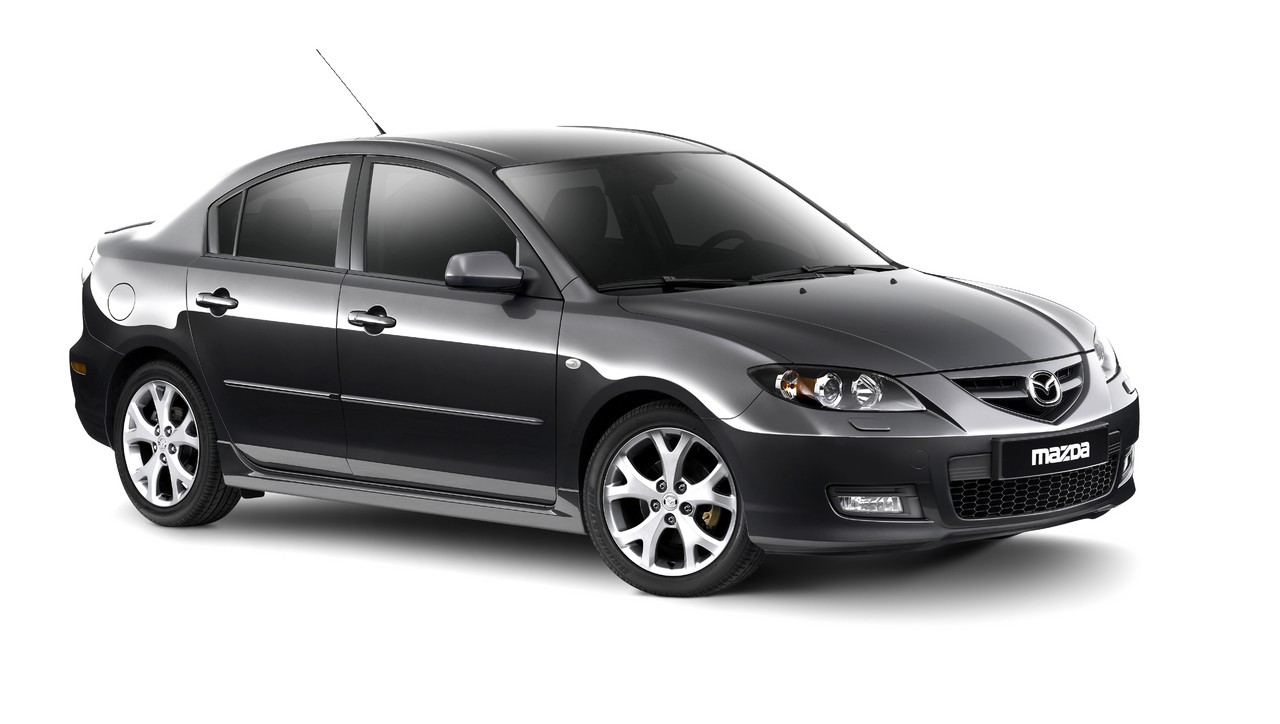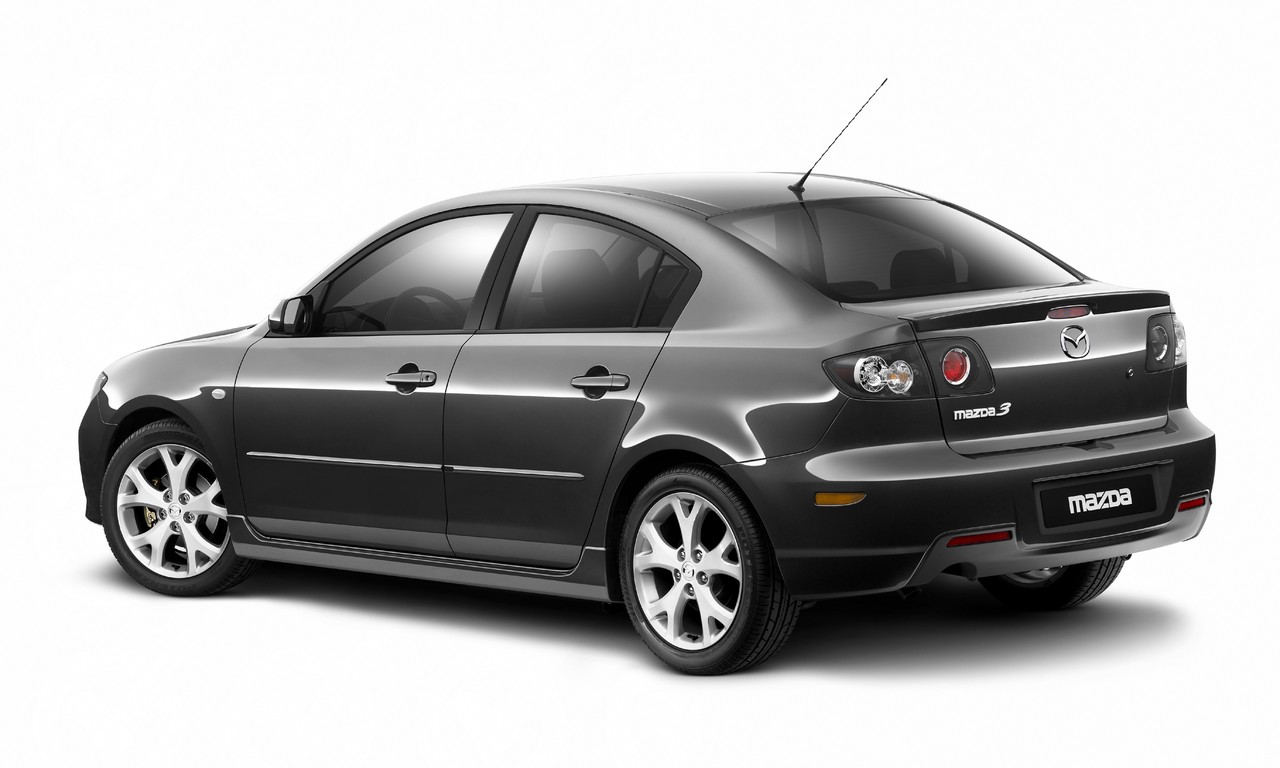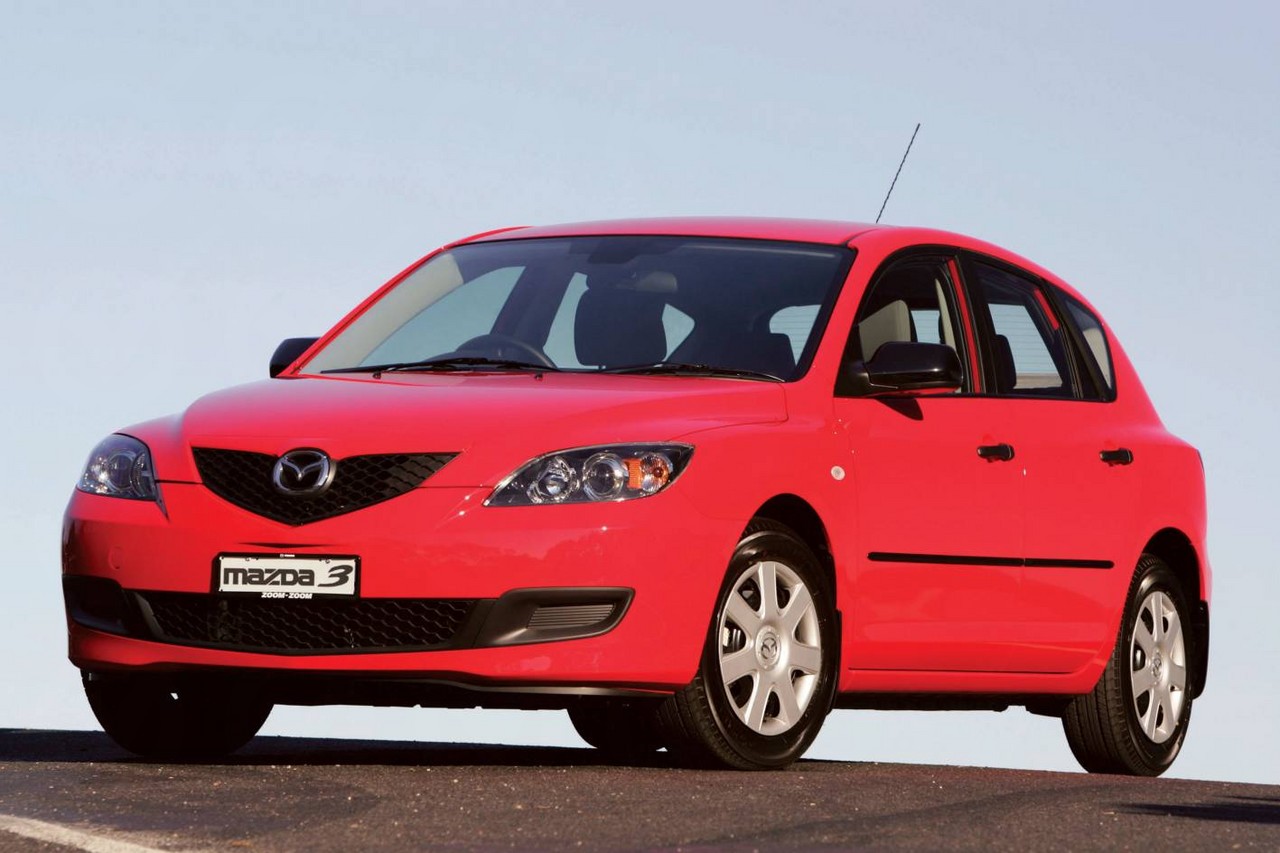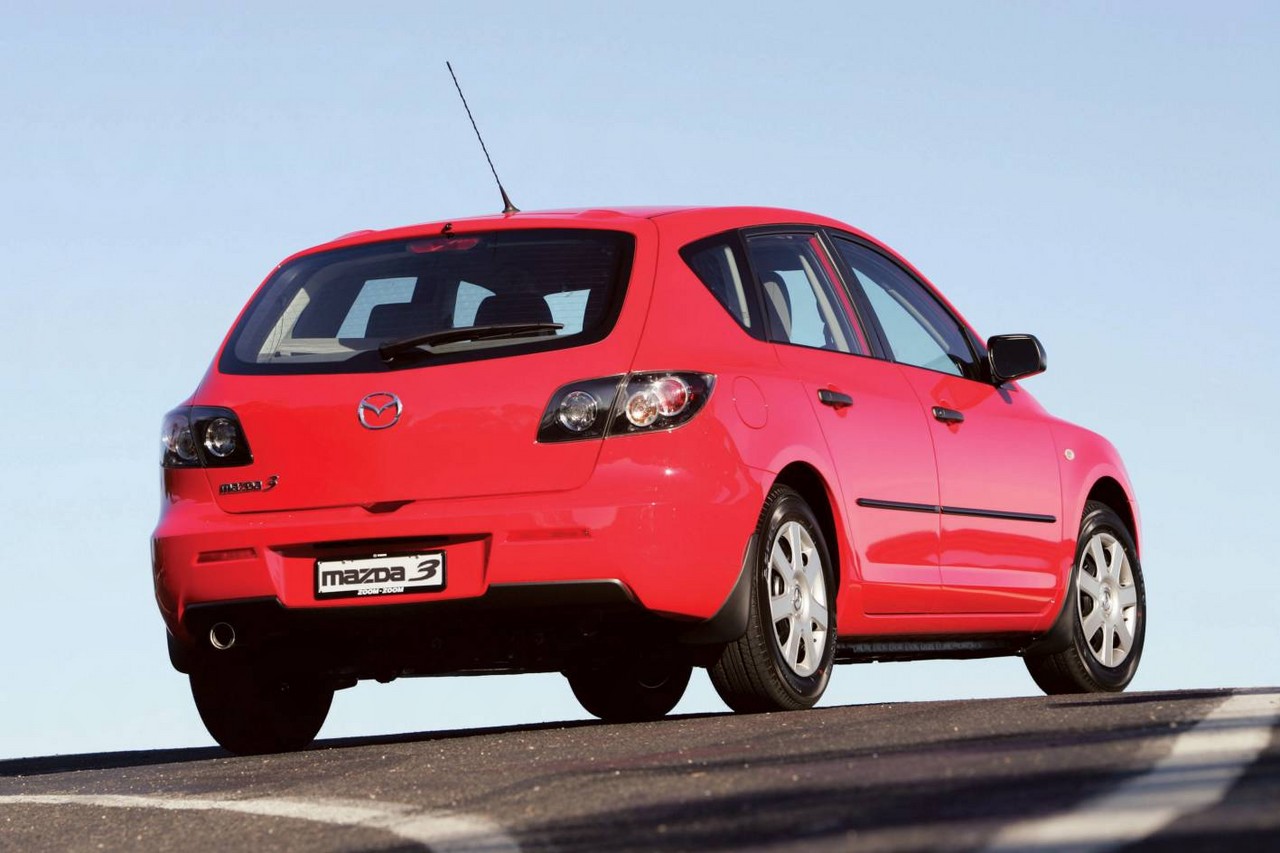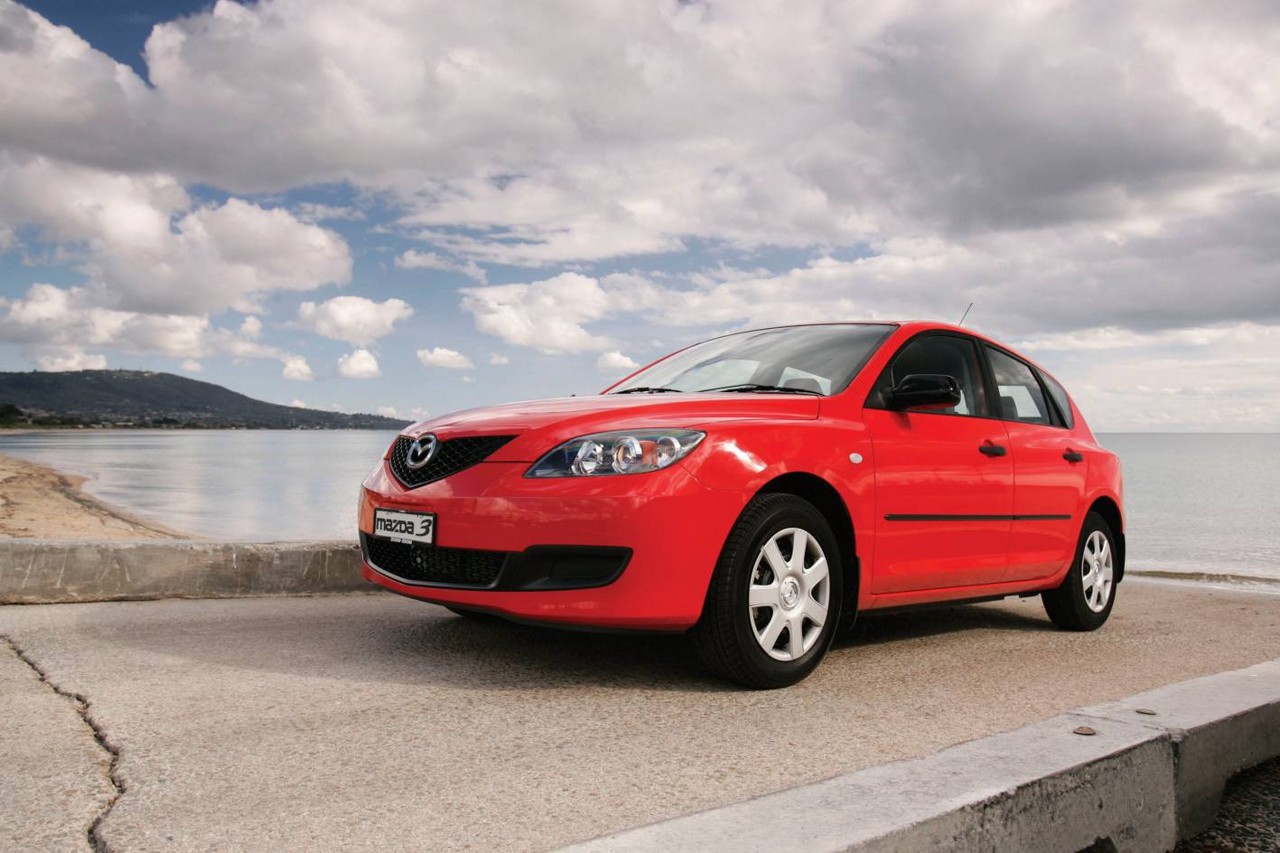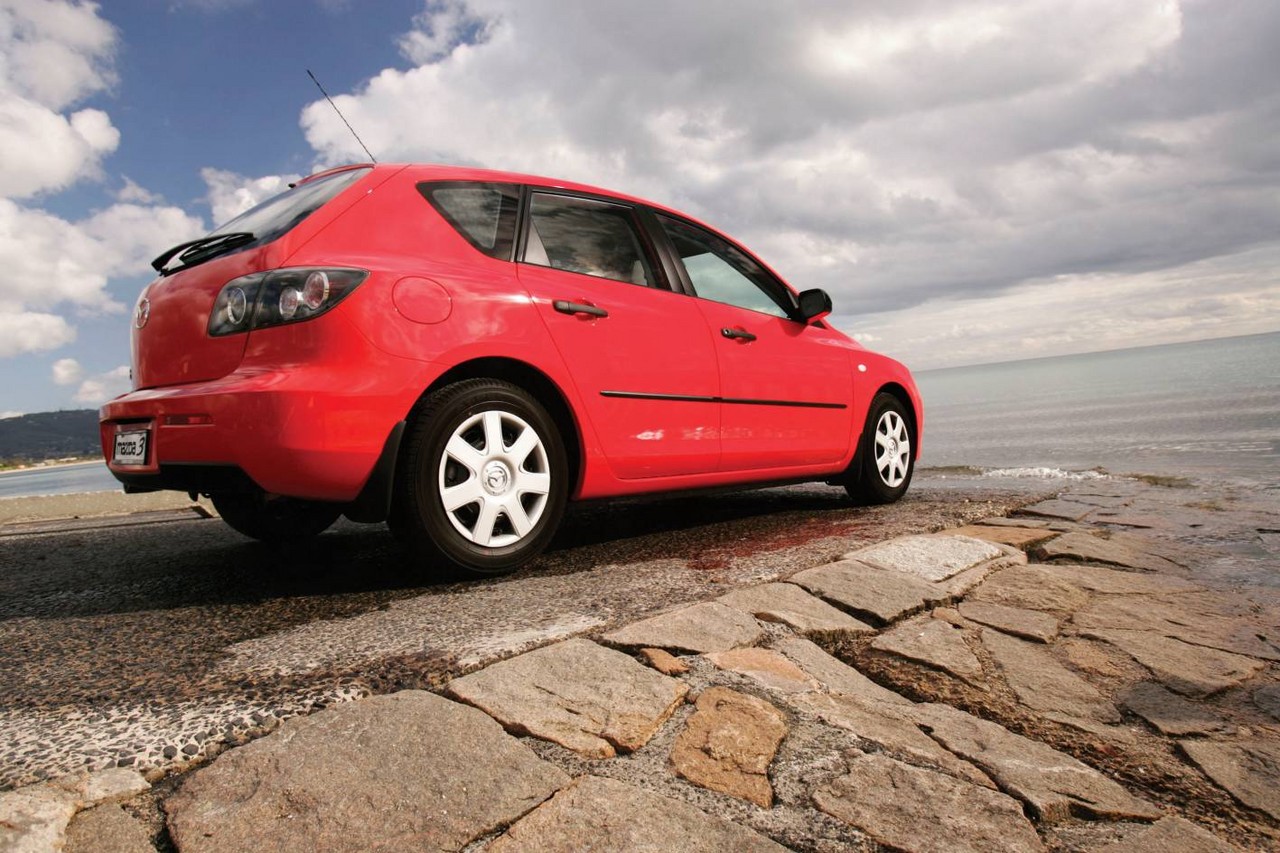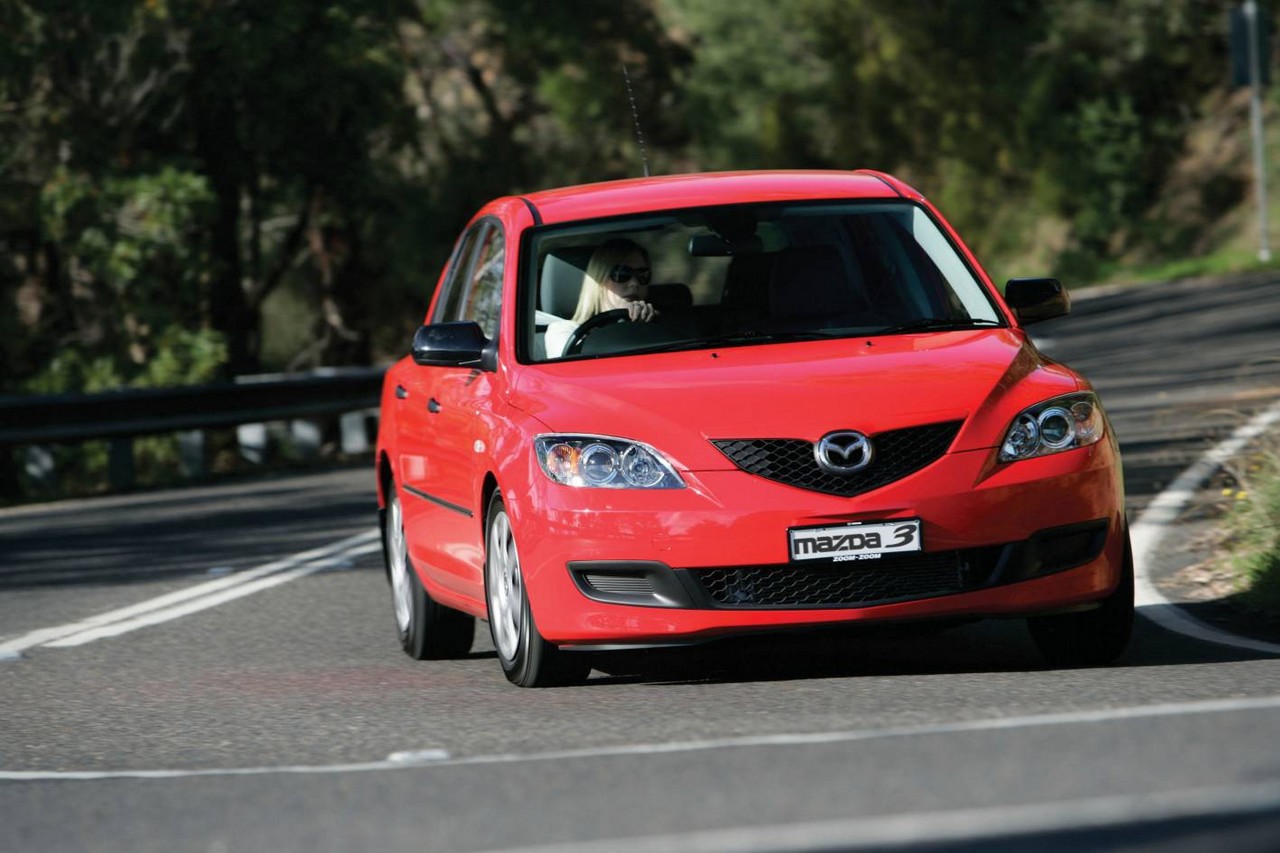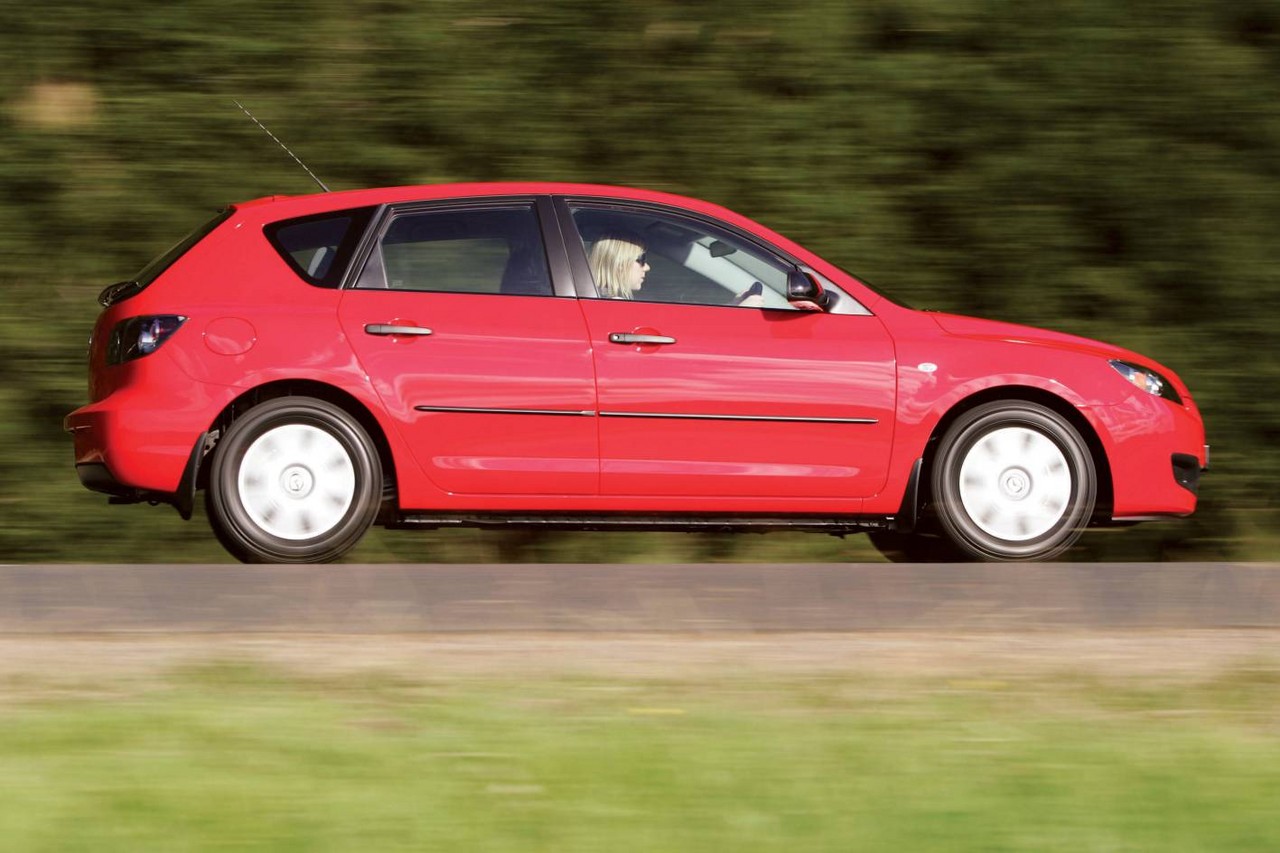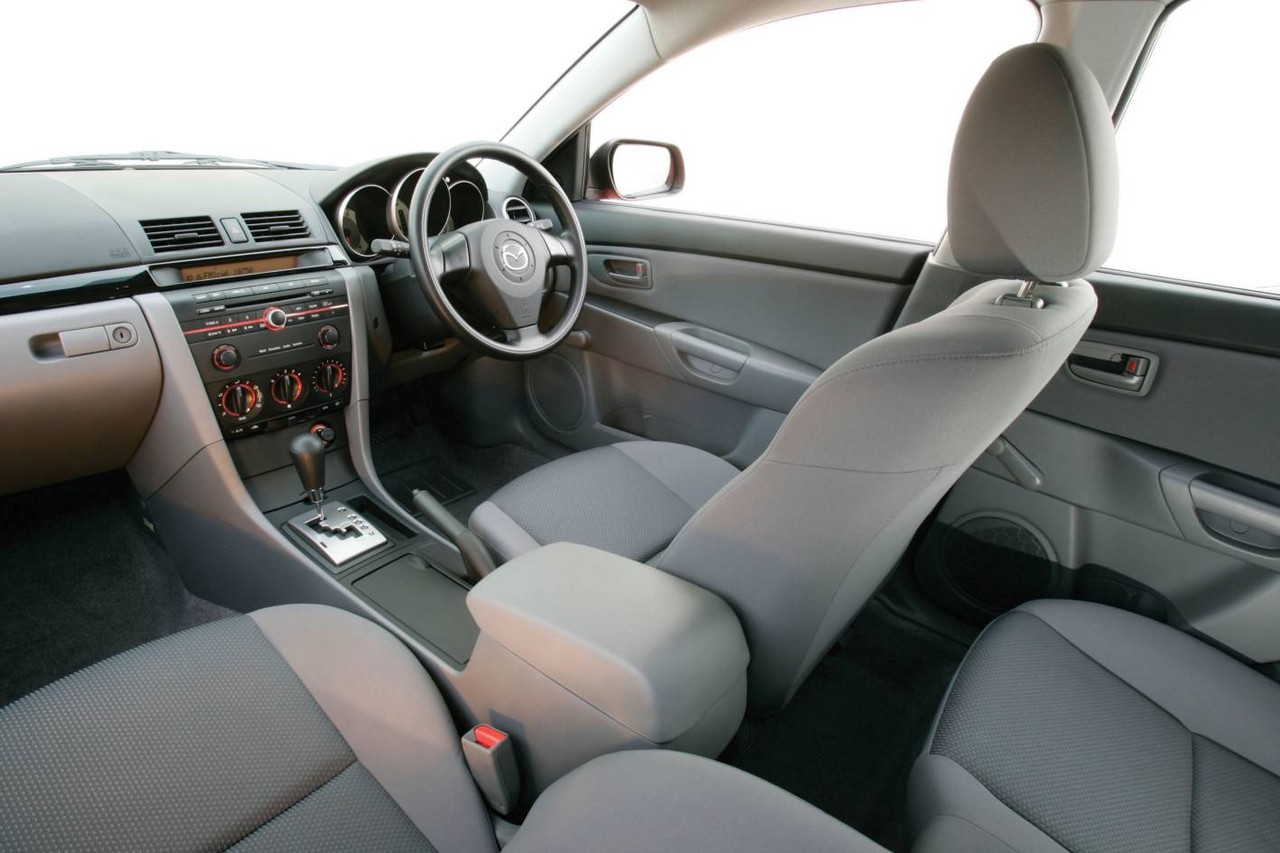
- Willing 2.0-litre petrol engines
- Responsive 2.2-litre turbo-diesel engine
- Supportive front seats
- Impressive ride/handling balance
- Cabin lacks sound insulation
- Engine vibrations at higher rpm
- Inconsistently weigted steering lacks feel
- Limited rear seat legroom
Review: Mazda BK.I Mazda3 (2004-06)
Overview
Released in January 2004, the Mazda BK Series I (BK.I) Mazda3 was available as a sedan or five-door hatchback. Manufactured in Hofu, Japan, the front-wheel drive Mazda3 was available with either 2.0- or 2.3-litre four-cylinder petrol engines.
LF-DE and L3-VE engines
Of these engines,
- For the Mazda3 Neo, Maxx and Maxx Sports, the 2.0-litre LF-DE engine had an aluminium alloy block and cylinder head, cast-iron cylinder liners, double overhead cams (chain-driven), four valves per cylinder and a compression ratio of 10.0:1; and,
- For the Mazda SP23, the 2.3-litre L3-VE engine had similar properties albeit with increased bore and stroke, variable intake camshaft timing (Mazda’s S-VT), a variable induction system (VIS) and a compression ratio of 9.7:1.
These engines were available with either five-speed manual or four-speed automatic transmissions, the latter featuring a sequential shift mode (Mazda’s ‘Activematic’).
Dimensions
Compared to the its Mazda BJ 323 which it replaced, the BK Mazda3 hatchback was 155 mm longer (at 4405 mm), while the sedan was 120 mm longer (4485 mm). For the other measurements, both the hatchback and sedan were 40 mm wider (at 1745 mm), 55 mm taller (1465 mm) and the wheelbase was 30 mm longer (2640 mm). Co-developed with the Ford Mk.2 Focus , the new body achieved a 40 per cent increase in bending rigidity.
Suspension
The Mazda BK Mazda3 had MacPherson strut front suspension and independent, four-link rear suspension (both with coil springs, double-acting shock absorbers and anti-roll bars).
| Body | Variant | Engine | Trans. | Peak power | Peak torque |
|---|---|---|---|---|---|
| 5dr hatch, 4dr sedan | Neo, Maxx, Maxx Sport |
2.0-litre LF-DE petrol I4 | 4sp auto, 5sp man. |
104 kW at 6500 rpm | 181 Nm at 4500 rpm |
| SP23 | 2.3-litre L3-VE petrol I4 | 4sp auto, 5sp man. |
115 kW at 6500 rpm | 203 Nm at 4500 rpm |
Safety equipment
Standard safety equipment for the Mazda BK.I Mazda3 Neo included dual front airbags and front seatbelts with pretensioners and load limiters. All other variants – i.e. the Mazda3 Maxx, Maxx Sport and SP23 – were further equipped with ABS, front side airbags, full-length curtain airbags (i.e. for front and rear occupants), electronic brake force distribution and brake assist; for the Neo, this equipment was available as part of an optional safety pack.
Brakes
The Mazda3 Neo, Maxx and Maxx Sport had 278 mm by 25 mm ventilated front disc brakes and 265 mm by 11 mm solid rear discs. The Mazda SP23, however, had 300 mm by 25 mm ventilated front discs and 280 mm by 11 mm solid rear discs.
ANCAP crash testing
In ANCAP crash testing , the BK.I Mazda3 – when fitted with dual front airbags, front side airbags and curtain airbags – received a four star adult occupant protection rating with a score of 26.56 out of 37. In the frontal offset crash test, protection from serious lower leg injury was marginal for the driver. In the side impact crash test, there was a marginal risk of serious chest injury for the driver. A pole test – which may have earned the Mazda3 an additional two points – was not performed.
Features: Mazda3 Neo, Maxx, Maxx Sport and SP23
Standard features for the Mazda3 Neo included 15-inch steel wheels with 195/65 R15 91V tyres, a four speaker stereo with CD player, air conditioning, remote central locking, a height and reach adjustable steering wheel and immobiliser.
The Mazda3 Maxx was further equipped with 15-inch alloy wheels, a six-stack CD player, steering wheel audio controls, power mirrors and power windows. Beyond this, the Maxx Sport added 16-inch alloy wheels with 205/55 R16 89V tyres and front fog lamps.
The range-topping Mazda3 SP23 was differentiated by its 17-inch alloy wheels with 205/50 R17 89V tyres, climate control air conditioning, external temperature gauges, leather-wrapped steering wheel and gearshift, stainless steel scuff plates, LED brake lights and a sports body kit.
Review: Mazda BK.II Mazda3 (2006-09)
Overview
Released in July 2006, the BK Series II (BK.II) Mazda3 introduced revised suspension, improved safety equipment and updated styling. Signficiantly, the 2.0-litre LF-DE engine was replaced by Mazda’s 2.0-litre LF-VE engine which added:
- Mazda’s ‘Sequential Valve Timing’ (S-VT) which varied intake valve timing according to engine speed for more efficient operation; and,
- A variable induction system (VIS) which varied intake manifold length to optimise intake efficiency according to engine speed.
Furthermore, electronic throttle control was made standard across the range.
Visually, the Mazda BK.II Mazda3 could be identified by its new bumper, grille, blacked-out tail-lights (for Neo, Maxx and Maxx Sport) and upgraded seat trims and dashboard finish.
Mazda3 Diesel
Introduced in August 2007, the Mazda3 Diesel was powered by Mazda;s 2.0-litre MZR-CD RF 2005 diesel engine which had a cast iron block, an alloy cylinder head, common-rail injection (operating at 1800 bar), a variable geometry turbocharger, exhaust gas recirculation, a single overhead camshaft (belt-driven), four valves per cylinder, compression ratio of 16.7:1 and a diesel particular filter (DPF).
| Body | Variant | Years | Engine | Trans. | Peak power | Peak torque |
|---|---|---|---|---|---|---|
| 4dr sedan, 5dr hatch | Neo | 2006-08 | 2.0-litre LF-VE petrol I4 | 4sp auto, 5sp man. |
108 kW at 6500 rpm | 182 Nm at 4500 rpm |
| Neo Sport | 2008-09 | |||||
| Maxx | 2006-08 | |||||
| Maxx Sport | 2006-09 | |||||
| Diesel | 2007-09 | 2.0-litre MZR-CD RF 2005 turbo-diesel I4 | 6sp man. | 105 kW at 3500 rpm | 360 Nm at 2000 rpm | |
| SP23 | 2006-09 | 2.3-litre L3-VE petrol I4 | 5sp auto, 6sp man. |
115 kW at 6500 rpm | 203 Nm at 4500 rpm |
Safety equipment
Safety equipment for the BK.II Mazda3 was enhanced with ABS, electronic brake force distribution and brake assist made standard across the range – these items had previously only been available as options for the Neo variant. The Mazda3 Diesel was further equipped with electronic stability control and traction control – these items were available as extra-cost options elsewhere in the range (i.e. for the Neo, Maxx and SP23 variants).
From April 2008, the SP23 was also fitted electronic stability control and traction control as standard.
Euro NCAP crash testing
In Euro NCAP crash testing , a 2006 BK.II Mazda3 with dual front airbags, front side airbags and curtain airbags received a four star adult occupant protection rating with a score of 32.87 out of 37. Although the Mazda3 received enough points for a five star rating, its performance in the frontal offset crash test did not meet the requirements for this rating – protection from serious leg injury was marginal for the front passenger and there was a slight risk of serious chest and leg injury for the driver. In the side impact crash test, there was a slight risk of serious chest injury for the driver.
Features
With the BK.II Mazda3, standard features were extended to include an auxiliary MP3 input and additional 12 volt power outlet in the centre armrest. The Maxx variant was also fitted with cruise control; the newly introduced Diesel variant had the same features as the Maxx Sports.
April 2008: Mazda3 update
The BK.II Mazda3 range was updated in April 2008, with the Maxx variant discontinued. Furthermore, the Neo was renamed ‘Neo Sport’ and fitted with 15-inch alloy wheels, an auxiliary iPod input, black cloth trim, power windows and power mirrors.
The Maxx Sport and Diesel variants were fitted with new 16-inch alloy wheels, chrome door handles, a Piano Black finish for the centre console and SP23-style cloth trim. In addition to electronic stability control and traction control, the SP23 was fitted with chrome door handles and Mazda3 MPS-style upholstery. The Mazda3 SP23 also received Piano Black finishes for the centre console, instrument panels and steering wheel.
Related links
